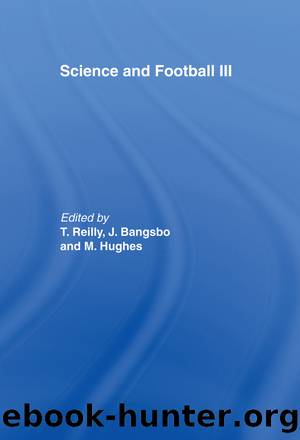Science and Football III by Bangsbo Jens;Reilly Thomas;Williams A. Mark;

Author:Bangsbo, Jens;Reilly, Thomas;Williams, A. Mark;
Language: eng
Format: epub
Publisher: Taylor & Francis Group
3 Injury Analysis
Injuries in rugby are inevitable because it is an intermittent, high intensity collision sport requiring considerable skill and fitness. The risk of injury can be reduced by ensuring that rugby players are physically and psychologically suited to participate in the game and this is particularly important with regard to the young, the old and women. It is important that, wherever possible, teams are composed of individuals who are appropriately matched for age, sex and maturity. Playersâ physique should be reviewed to include assessment of joint mobility as hypermobility is believed to carry an increased risk or injury. An individualâs personality may also be of relevance as well as his or her general state of health. The choice of an appropriate training programme reviewing intensity, duration, frequency and content to ensure an appropriate work-rest ratio is also essential.
The risk of injury in rugby is minimised by ensuring that the laws by which the game is regulated are soundly formulated and properly supervised by the referee. The game must also be played on a good surface and in a safe environment.
The Scottish Rugby Union, through its Medical Advisory Committee, has undertaken a series of studies over the years on rugby injuries. After a series of pilot studies, the Scottish Rugby Union would encourage all rugby clubs to report injuries that resulted in a playerâs admission to hospital or in the death of a player. This system is based on the co-operation of clubs and is inevitably associated with underreporting. Various information has, however, been identified which has proved of considerable interest. Between 1979 and 1994, six deaths have occurred in Scottish rugby from which only one was directly related to the game in that a player died following a high cervical spinal cord injury resulting in quadriplegia. Five other deaths have taken place due to coincidental medical conditions including three myocardial infarcts, one player with hypertrophic cardiomyopathy and one spontaneous cerebral haemorrhage. Three other players in the same period have suffered a quadriplegia as a result of scrummaging and one tackling injury. In addition we have recorded a series of other life threatening injuries including one player who developed tetanus, two players with ruptured spleens, one player who required a nephrectomy and two players with haemopneumothorax. There have also been two players with serious head injuries which required craniotomy.
The most common injury requiring hospital admission is concussion, accounting for 17% of all reported serious injuries. Injuries to the ligaments of the knee and fractures of the cheek bone and leg make up the bulk of all remaining injury reports. These injuries are attributed to the tackle in 70 % of occasions with 60 % of the most seriously injured players being the individual who has been tackled. The frequency of replacements increases as the game progresses, 43 % of replacements taking place in the fourth quarter. The most commonly injured players are the flanker, prop-forward, No 8 and lock (Sharp et al., 1992).
The Accident & Emergency Department of the Borders General Hospital in Scotland recorded all injured players who presented during the season 1990â91.
Download
This site does not store any files on its server. We only index and link to content provided by other sites. Please contact the content providers to delete copyright contents if any and email us, we'll remove relevant links or contents immediately.
Periodization Training for Sports by Tudor Bompa(8110)
Bodyweight Strength Training by Jay Cardiello(7814)
Therapeutic Modalities for Musculoskeletal Injuries, 4E by Craig R. Denegar & Ethan Saliba & Susan Saliba(7669)
Born to Run: by Christopher McDougall(7037)
Imperfect by Sanjay Manjrekar(5754)
Wiseguy by Nicholas Pileggi(5621)
Shoe Dog by Phil Knight(5088)
Paper Towns by Green John(5046)
The Body: A Guide for Occupants by Bill Bryson(4903)
The Rules Do Not Apply by Ariel Levy(4804)
Endurance: Shackleton's Incredible Voyage by Alfred Lansing(4639)
Tuesdays with Morrie by Mitch Albom(4618)
Bodyweight Strength Training Anatomy by Bret Contreras(4586)
Yoga Anatomy by Kaminoff Leslie(4256)
The Sports Rules Book by Human Kinetics(4228)
Science and Development of Muscle Hypertrophy by Brad Schoenfeld(4068)
Dynamic Alignment Through Imagery by Eric Franklin(4059)
Machine Learning at Scale with H2O by Gregory Keys | David Whiting(3997)
Alive: The Story of the Andes Survivors by Piers Paul Read(3935)
